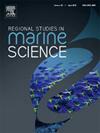Habitat suitability of two benthopelagic fish species in the Caspian Sea using maximum entropy model
IF 2.1
4区 环境科学与生态学
Q3 ECOLOGY
引用次数: 0
Abstract
Protecting valuable aquatic reserves requires understanding marine species' geographical locations and selected habitats. The current research uses the maximum entropy model (MaxEnt) and 21 environmental parameters to model the distribution of Chelon saliens, and Vimba persa, in the Iranian coast waters of the Caspian Sea (CS). The study encompassed 302 sampling efforts, where presence percentages for C. saliens, and V. persa were 203 (50.87 %), and 99 (24.81 %), respectively. The optimal algorithm for C. saliens was random forest (rf), achieving 83 % accuracy. For V. persa, the best-performing algorithm was the support vector machine (svm), with an accuracy of 80 %. The area under the system performance characteristic curve (AUC) learning scores for each species was above 0.9, indicating the high predictive power of the MaxEnt model in determining species' actual distribution. For C. saliens, key environmental factors such as oxygen percentage saturation (DO%, 34 %), photosynthetically active radiation (PAR, 11 %), and sea surface temperature (SST, 7 %) played a significant role in predicting the species distribution. Similarly, for V. persa, environmental variables such as PAR (34 %), SST (19 %), and ammonium (7 %) emerged as the most influential predictors. Based on this model, the percentage of high-desirability habitats in V. persa and C. saliens varied from 38 % to 73 %, respectively. In conclusion, because of the ecological importance of these benthopelagic species, it is imperative to implement appropriate management strategies. These should include protecting desirable habitats, enforcing fishing bans in certain areas, and attempting to develop suitable areas to mitigate potential harm to their populations.
利用最大熵模型分析里海两种底栖鱼类的生境适宜性
保护宝贵的水生保护区需要了解海洋物种的地理位置和选定的栖息地。目前的研究使用最大熵模型(MaxEnt)和21个环境参数来模拟在里海伊朗海岸水域(CS)的Chelon saliens和Vimba persa的分布。该研究包括302次采样,其中斑点弧菌和人弧菌的存在率分别为203(50.87 %)和99(24.81 %)。最优算法为随机森林(rf),准确率为83% %。对于V. persa,表现最好的算法是支持向量机(svm),准确率为80 %。各物种的系统性能特征曲线下面积(AUC)学习得分均在0.9以上,表明MaxEnt模型在确定物种实际分布方面具有较高的预测能力。氧饱和度(DO%, 34 %)、光合有效辐射(PAR, 11 %)和海温(SST, 7 %)等关键环境因子对沙蚕的分布具有重要的预测作用。同样,对于弧菌,PAR(34 %)、海温(19 %)和铵(7 %)等环境变量成为最具影响力的预测因子。基于该模型,拟南蝽和拟南蝽的高期望生境比例分别为38% % ~ 73% %。综上所述,由于这些底栖物种的生态重要性,必须实施适当的管理策略。这些措施应包括保护理想的栖息地,在某些地区实施捕鱼禁令,并努力开发适当的地区以减轻对其人口的潜在危害。
本文章由计算机程序翻译,如有差异,请以英文原文为准。
求助全文
约1分钟内获得全文
求助全文
来源期刊

Regional Studies in Marine Science
Agricultural and Biological Sciences-Ecology, Evolution, Behavior and Systematics
CiteScore
3.90
自引率
4.80%
发文量
336
审稿时长
69 days
期刊介绍:
REGIONAL STUDIES IN MARINE SCIENCE will publish scientifically sound papers on regional aspects of maritime and marine resources in estuaries, coastal zones, continental shelf, the seas and oceans.
 求助内容:
求助内容: 应助结果提醒方式:
应助结果提醒方式:


